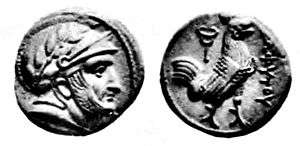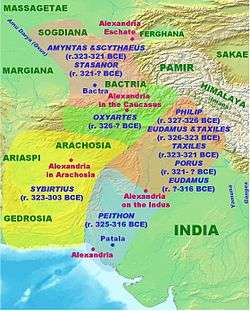Sophytes
| Sophytes ΣΩΦΥΤΟΥ | |
|---|---|
| Ruler or Satrap | |
|
Coin of Sophytes. Obv: Sophytes in profile with tight helmet and wreath. Rev: Cock standing to right, with caduceus, and legend in Greek: ΣΩΦΥΤΟΥ "Sophytes". | |
| Reign | circa 300 BCE |

Sophytes, or Sopeites,[1] Sophytos, is the name of a king or satrap who ruled circa 300 BCE in Bactria or in the northwestern Indian subcontinent, and whose exact identity is shrouded in mystery.
Sophytes the Indian ruler
Sophytes is described in classical sources as a ruler in the Punjab region between the Hydraotes and the Hyphasis in the area of the Salt Range, who submitted to Alexander and was, thereby, permitted to retain his realms, probably as a vassal of Porus.[1] He made a demonstration of four Indian dogs fighting a lion to Alexander.[1][2] Sophytes is described as ruling along the Indus during the campaigns of Alexander the Great, in the Bibliotheca of Diodorus Siculus. Curtius also records an interview between the tall and handsome Sophytes and Alexander.
"Next he undertook a campaign against the cities under the rule of Sopeithes. These are exceedingly well-governed. All the functions of this state are directed toward the acquiring of good repute, and beauty is valued there more than anything. (...) Their king Sopeithes was strikingly handsome and tall beyond the rest, being over four cubits in height. He came out of his capital city and gave over himself and his kingdom to Alexander, but received it back through the kindness of the conqueror. Sopeithes with great goodwill feasted the whole army bountifully for several days." Bibliotheca of Diodorus Siculus Book 17[3]
Sophytes the satrap

Possibly another Sophytes is also known from his abundant Greek coinage dated circa 300 BCE. Little is known about him and hypotheses are numerous: Sophytes may have been a Hellenistic satrap who replaced Stasanor in Bactria-Sogdiana, or may have ruled in a neighboring area;[4] he may also have been a Satrap of Arachosia.[5]
His rich and formal Greek coinage is however generally considered as Bactrian due to the distribution of the finds, and due to the coin types, of Athena with owl and eagle reverses, which are a clear continuation of the Attic coinage and the preceding anonymous Bactrian coin types derived from it.[4] The coinage of Sophytes is often dated to 305-294 BCE[6]
 Attic drachm, Athena type, Middle East, 4th century BCE. A precussor of the Sophytes coins.
Attic drachm, Athena type, Middle East, 4th century BCE. A precussor of the Sophytes coins. Attic drachm, Athena type, Central Asia, 4th century BCE. A precussor of the Sophytes coins.
Attic drachm, Athena type, Central Asia, 4th century BCE. A precussor of the Sophytes coins. Coin of Sophytes, clearly derived from these previous Attic coins.[4]
Coin of Sophytes, clearly derived from these previous Attic coins.[4]
Ethnicity

Sophytos is not a Greek name.[7] Scholars, including Sylvain Lévi, have suggested, based on Panini, that the name Sophytes may be equated with the name Saubhūti, but there is no conclusive proof of this. It is not clear if this king Sophytes is the same as the individual named Sophytes on coins discovered in the northwest of the Indian subcontinent, or whether he was a later dynast based in Bactria. E.J. Rapson thinks that they are one and the same[2]
Sophytes has been subject to a lot of speculation, with Indian origin at one end of the spectrum and Greek at the other. Cunningham identifies him with the Indian King Fobnath of "Sangala," (a name some read as "Saka-town") while A. C. L. Carlleyle connects him with the same king's son Suveg, which is more likely in light of the identification of Fobnath as a royal title rather than a name; potentially making him a Madra of Saka/Iranian origin. Cunningham believes the Sobii and Kathaei to have been his subjects, whom he asserts were Turanians, making them of the same stock as the Saka or Indo-Scythians. It is interesting to note that Sagala was the capital of the later Indo-Greek dynasty of Menander I for several generations, and that Menander himself struck several coins with a similar reverse, suggesting that his dynasty inherited the older king's mints when he took the city for himself.
John D. Grainger however, identifies him as a Greek dynast; Frank L. Holt speculating that he was a mercenary captain who minted coins simply to meet the needs of his troops. In light of his coin type, he may have been a local official, installed (although he may have been an older official, reinstated or simply recognized) by Seleucus after he took the region.
Another Sophytes is known from the Kandahar Sophytos Inscription, who may or not have been related to this Sophytes.[5]
Sources
- Age of the Nandas and Mauryas, Nilakantha Shastri, Motilal Banarsidass (1967)
- Hellenism in Ancient India, Gauranga Nath Banerjee, Munshiram Manoharlal.
- Archaeological Survey of India - Report of Tours in the Central Doab and Gorakhpur in 1874-75 and 1875-76, A. C. L. Carrleyle and Maj. General Arthur Cunningham, Calcutta: Office of the Superintendent of Government Printing.
- Symbols: Their Migration and Universality, Count Eugene Goblet d'Alviella, Dover Publications.
- The Greeks in Bactria and India, Sir W. W. Tarn, Ares Publishers.
- A Seleukid Prosopography and Gazetter, John D. Grainger, Brill.
- Thundering Zeus: The Making of Hellenistic Bactria, Frank L. Holt, University of California Press.
References
- 1 2 3 Who's Who in the Age of Alexander the Great: Prosopography of Alexander's Empire, Waldemar Heckel John Wiley & Sons, 2008, p.267
- 1 2 Ancient India: From the Earliest Times to the First Century AD, E. J. Rapson Cambridge University Press, 2011, p.152
- ↑ Bibliotheca of Diodorus Siculus Book 17
- 1 2 3 Alexander the Great and Bactria: The Formation of a Greek Frontier in Central Asia, Frank Lee Holt, Brill Archive, 1988, p.97
- 1 2 Histoires grecques, Maurice Sartre, Le Seuil
- ↑
- ↑ The Muse at Play: Riddles and Wordplay in Greek and Latin Poetry, Jan Kwapisz, David Petrain, Mikolaj Szymanski, Walter de Gruyter, 2013, p.284-287
